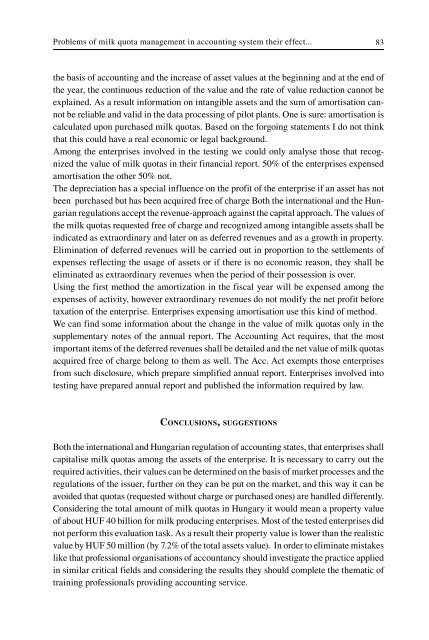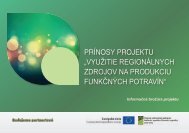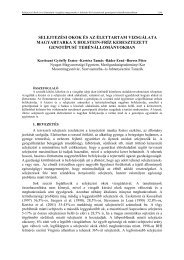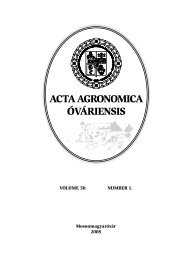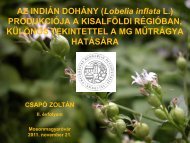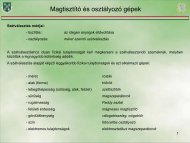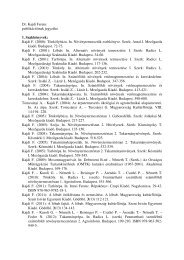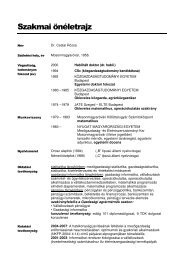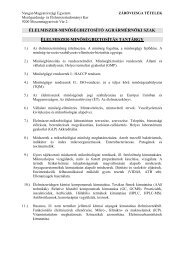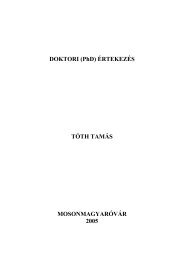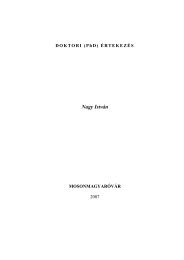teljes anyag - Nyugat-Magyarországi Egyetem Mezőgazdaság
teljes anyag - Nyugat-Magyarországi Egyetem Mezőgazdaság
teljes anyag - Nyugat-Magyarországi Egyetem Mezőgazdaság
You also want an ePaper? Increase the reach of your titles
YUMPU automatically turns print PDFs into web optimized ePapers that Google loves.
Problems of milk quota management in accounting system their effect...83the basis of accounting and the increase of asset values at the beginning and at the end ofthe year, the continuous reduction of the value and the rate of value reduction cannot beexplained. As a result information on intangible assets and the sum of amortisation cannotbe reliable and valid in the data processing of pilot plants. One is sure: amortisation iscalculated upon purchased milk quotas. Based on the forgoing statements I do not thinkthat this could have a real economic or legal background.Among the enterprises involved in the testing we could only analyse those that recognizedthe value of milk quotas in their financial report. 50% of the enterprises expensedamortisation the other 50% not.The depreciation has a special influence on the profit of the enterprise if an asset has notbeen purchased but has been acquired free of charge Both the international and the Hungarianregulations accept the revenue-approach against the capital approach. The values ofthe milk quotas requested free of charge and recognized among intangible assets shall beindicated as extraordinary and later on as deferred revenues and as a growth in property.Elimination of deferred revenues will be carried out in proportion to the settlements ofexpenses reflecting the usage of assets or if there is no economic reason, they shall beeliminated as extraordinary revenues when the period of their possession is over.Using the first method the amortization in the fiscal year will be expensed among theexpenses of activity, however extraordinary revenues do not modify the net profit beforetaxation of the enterprise. Enterprises expensing amortisation use this kind of method.We can find some information about the change in the value of milk quotas only in thesupplementary notes of the annual report. The Accounting Act requires, that the mostimportant items of the deferred revenues shall be detailed and the net value of milk quotasacquired free of charge belong to them as well. The Acc. Act exempts those enterprisesfrom such disclosure, which prepare simplified annual report. Enterprises involved intotesting have prepared annual report and published the information required by law.CONCLUSIONS, SUGGESTIONSBoth the international and Hungarian regulation of accounting states, that enterprises shallcapitalise milk quotas among the assets of the enterprise. It is necessary to carry out therequired activities, their values can be determined on the basis of market processes and theregulations of the issuer, further on they can be put on the market, and this way it can beavoided that quotas (requested without charge or purchased ones) are handled differently.Considering the total amount of milk quotas in Hungary it would mean a property valueof about HUF 40 billion for milk producing enterprises. Most of the tested enterprises didnot perform this evaluation task. As a result their property value is lower than the realisticvalue by HUF 50 million (by 7.2% of the total assets value). In order to eliminate mistakeslike that professional organisations of accountancy should investigate the practice appliedin similar critical fields and considering the results they should complete the thematic oftraining professionals providing accounting service.


